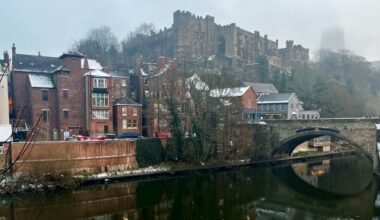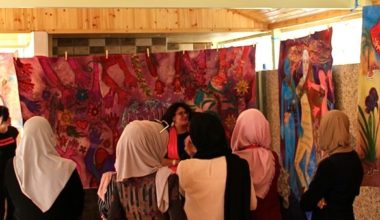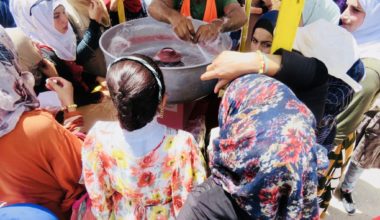
By Alessandra Caselli, doctoral student in the Archaeology of the Near East at Sapienza University of Rome.
Between the spring and summer of 2018, I had the pleasure of spending three months at CBRL’s British Institute in Amman to conduct research on one of the archaeological collections currently stored there. My doctoral thesis focuses on the Zarqa valley (north of Amman, Jordan) in the 4th millennium BC, a period of great importance as it lays the foundations for the establishment of urban societies: in the Early Bronze Age I period (ca. 3700-3100 BC), new cultural and economic impulses determined the development of sedentarism and the beginning of the urbanisation process which was to fully take place in the Early Bronze Age II (3100-2900 BC).
For the past five years, I have been working with the Spanish-Italian archaeological mission of Jebel al-Mutawwaq, an Early Bronze Age I site located in this Zarqa region. It is a large site made up of an ancient settlement surrounded by a boundary wall. Inside the ancient village, the only Early Bronze Age I sanctuary ever to be discovered in Jordan can be observed. Furthermore, the hinterland of the village boasts a large necropolis featuring megalithic burials.

In order to put Jebel al-Mutawwaq’s findings into their wider context, an important part of my research is to study past survey and excavation reports from the Zarqa region, with the aim of improving our understanding of the chronology of occupation recorded by earlier missions. The most notable projects carried out in this region are those by Hanbury-Tenison (Hanbury Tenison 1987, 1989) between 1984 and 1986, Gaetano Palumbo in the 1990s (Palumbo 1994, 1996, 1997), and, most recently, by Lorenzo Nigro in 2007 (Nigro 2008).
At the beginning of 2017, after reading one of Hanbury-Tenison’s reports published in the Annual of the Department of Antiquities of Jordan (ADAJ 31 for 1987) and ADAJ 33 (1989), I noticed that the British Institute at Amman for Archaeology and History (BIAAH, now known as CBRL’s British Institute in Amman) was given as the place where the material from Hanbury-Tenison’s survey projects were stored. An email to Dr Carol Palmer, director of the Institute, in late 2017, did indeed confirm that Hanbury-Tenison’s legacy collections were still housed there.
Thanks to a mobility grant by Sapienza University and to the support of CBRL’s Dr Palmer, in April 2018 I was able to travel to Amman to begin a three-month period of study of these materials whilst being hosted at CBRL’s Amman Institute.

A first inspection of Hanbury-Tenison’s material proved most of it to be made up of (mostly diagnostic) pottery sherds, flint, and basalt objects. Most of the ensuing twelve weeks were spent drawing, photographing and entering nearly 1035 objects into my PhD thesis’ database. A main focus of this study was that of picking out sites that witnessed a phase of occupation in the 4th millennium BC, with the goal of separating out Chalcolithic (4000-3800 BC) from Early Bronze Age I (3700-3100 BC) sites, which are contemporary to Jebel al-Mutawwaq. Identifying occupation dated to the 4th millennium presents some significant challenges due to the highly localised nature of the material culture of this period. For this reason, the material culture of Jebel al-Mutawwaq, whose chronology of occupation has been clarified by the Spanish-Italian excavations over the last few years, is crucial in allowing us to identify sites in the Zarqa region which were occupied between the Late Chalcolithic and the Early Bronze Age I.
The Hanbury-Tenison materials which were analysed come from 33 sites and although more work will be needed to clarify their chronology of occupation, preliminary analysis has already confirmed a 4th millennium occupation at the sites of Karmah, Tell Riyashi, Haziyeh, Kharaysin and Umm Bteimeh.

In the rare breaks from the study of this exciting material, I tried to improve my knowledge of Arabic through a combination of private tuition and impromptu conversations with the wonderful staff of the Institute and the welcoming people of Amman. Moreover, life in the Institute made it easy to meet researchers from different countries and areas of specialism, favouring a stimulating cultural exchange and providing an opportunity to improve my English.
My three months at CBRL’s British Institute in Amman were marked by a combination of hard work in the Institute’s lab and stimulating cultural exchanges and conversations, field trips around Jordan and dinners out in Amman, all of which have made my stay very special.
Further reading
HANBURY TENISON, j.w. 1987: Jerash region survey 1984, ADAJ 31 (1987), pp.129-157.
HANBURY TENISON, j.w. 1989: Jebel Mutawwaq 1986, ADAJ 33 (1989), pp. 137-144.
PALUMBO,G. 1994: The Jordan Antiquities database and information system. A summary of the data, Amman 1994.
PALUMBO, G. 1996: The wadi az-Zarqa/ wadi ad-Dulayl Excavations and survey project: report on the october-november 1993 fieldwork season, ADAJ XL, pp. 375-426
PALUMBO, G. 1997: The wadi az-Zarqa/wadi adh-Dhulayl archaeological project, report on the 1996 fieldwork season, ADAJ XLI, pp. 9-26.
NIGRO, L. et al. 2008: Preliminary report of the third season of excavations of Rome “La Sapienza” University at Khirbat al-Batrawy (Upper Wadi az-Zarqa), ADAJ 52, pp. 209-230.
Alessandra Caselli is a Near Eastern archaeologist. She graduated from the University of Perugia in 2015 and, since 2016 has been a PhD student at Sapienza University of Rome. Her PhD project is focused on Transjordan, and especially the wadi az-Zarqa Valley, during the 4th Millennium BC. Her research is focusing on the socio-cultural dynamics at the beginning of the Early Bronze Age. She has been a member of the Spanish-Italian expedition at Jebel al-Mutawwaq (Jordan) co-directed by Dr Andrea Polcaro (University of Perugia) and Dr Juan Muniz (Pontificia Falcultad San Esteban of Salamanca) since 2013. Furthermore, she is a member of the Italian expedition at Tell Zurghul/ Nigin (Southern Iraq) co-directed by Dr Davide Nadali (La Sapienza University of Rome) and Dr Andrea Polcaro (University of Perugia) since 2015.
The views expressed by our authors on the CBRL blog are not necessarily endorsed by CBRL, but are commended as contributing to public debate.














